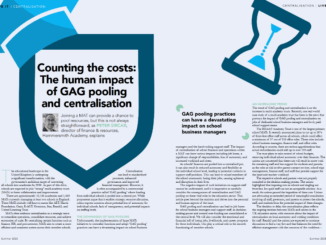Navigating the budgeting process can be both a relief and a source of anxiety for SBLs, particularly when awaiting confirmation of crucial financial figures. Clare Skinner has a comprehensive checklist of steps to help you feel more in control
You’ve drafted a budget for 2024-25 using all the available data to date – you just need confirmation of that big number that is driven from your GAG statement. Your headteacher is constantly asking if the information is here and you keep advising that it will be soon and then…they land!
You go into the document with trepidation, click on the download button and look at the number on page 2 of the GAG statement. What is your reaction? It is likely to be a sigh of relief or a wave of anxiety depending on that one number…
Take a breath, count to ten and then do the following things to get a grip on that number.
- Check that the statement is correct! Review against your October census numbers on roll
- Determine your workload – compare the GAG amount to your early draft budget to assess how far away you were from your original forecast and what you need to work on to achieve a realistic and balanced budget
- Update your budgeting software with the confirmed numbers on income to clarify your surplus/deficit forecast position to prepare for the next step
- Prepare your pitch – I always print a copy of the GAG statement for my headteacher and write the current year’s information on it next to the next year’s allocation. This helps to provide a clear picture on changes from one year to the next and clarify why savings may be needed or confirm that those expenditure increases are possible
- Get onto your ICFP and drill down into staffing costs to identify what changes are needed working with the headteacher, curriculum lead and timetable to do this. Understand what is realistic, gaining a full understanding of any structural changes that are needed so that trustees can be engaged in next steps for consultation or recruitment as appropriate
- Get the budget forecast onto the SLT agenda for discussion in conjunction with the SDP. Walk away from that meeting having ensured that all strategic plans are costed so that items can be prioritised and amended in line with the budget
- Drill down into every budget line and assess against actual spend and agreed contract details to ensure that expenditure is realistic and not just increasing by the same amount on every line for every year. Not every year needs the same expenditure, some things arise biannually and some triennially so remember to factor those nuances in
- Review, review, review during Summer 1 – as soon as a resignation is received, as soon as capital funding is announced, as soon as Pupil Premium allocations are confirmed – update that forecast so you are on top of it and other decisions can be flexed in light of the latest news
- Submit a draft to your trustees with all assumptions and annotations on the forecast to ensure that all questions can be asked and answered or taken away for further investigation
- Finalise all points ready to gain approval of the budget to be submitted to the ESFA
You may repeat this cycle on several occasions between receiving your GAG Statement and submitting your 3-year Budget Forecast to the ESFA. Be prepared to do as many times as is needed to get this as accurate as possible and remember if you are operating multiple scenarios to update every version appropriately!
I’m not going to lie; this is a stressful and challenging time of the year for SBLs. The challenge we receive around this process is at a high level, especially when money is tight, and we are effectively telling people that they are going to have to make very difficult decisions in some cases.
Remember that you are there to provide information and guidance around achieving a balanced budget but that the budget belongs to everyone in the trust with many people having a role to play in setting that budget and everyone in the trust having to deliver it.




Be the first to comment